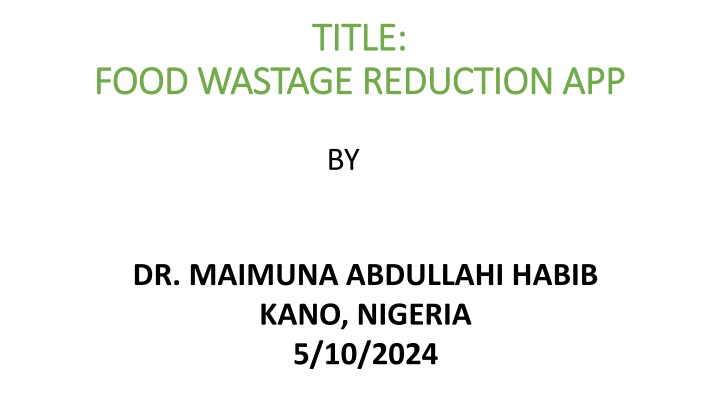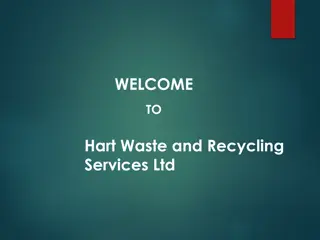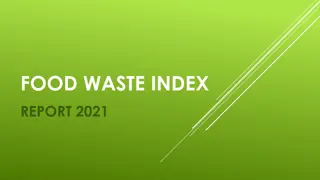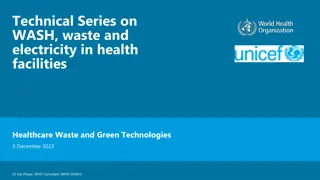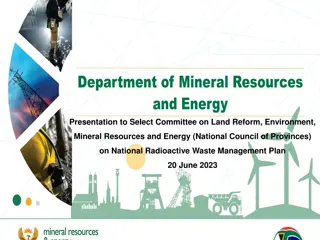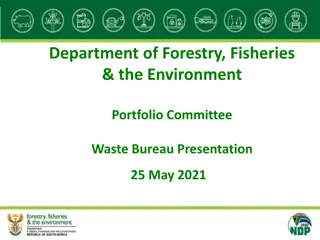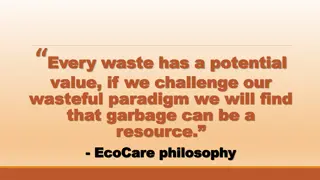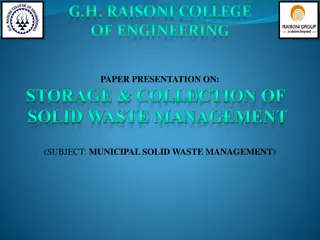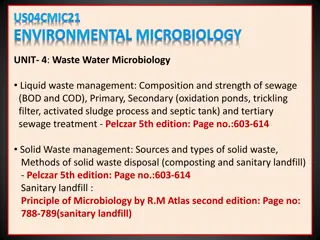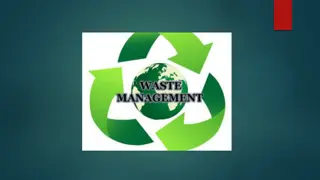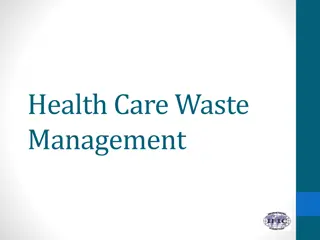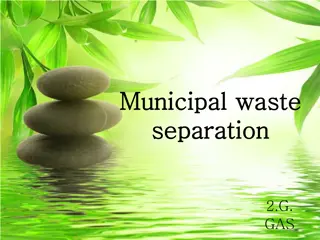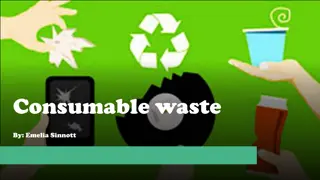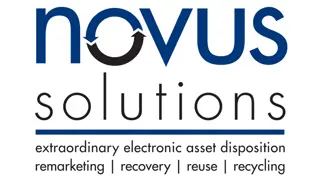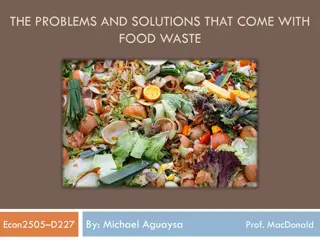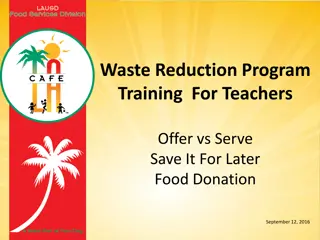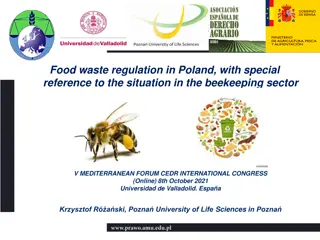Food Waste Reduction App for Sustainable Solutions
Connect donors with excess food to those in need through a platform that promotes sustainability, community support, and social responsibility. Reduce food waste, feed vulnerable populations, and support local economies. The app features donation platforms, recipient networks, location-based matching, real-time updates, food safety guidelines, user profiles, feedback systems, and educational resources.
Download Presentation

Please find below an Image/Link to download the presentation.
The content on the website is provided AS IS for your information and personal use only. It may not be sold, licensed, or shared on other websites without obtaining consent from the author.If you encounter any issues during the download, it is possible that the publisher has removed the file from their server.
You are allowed to download the files provided on this website for personal or commercial use, subject to the condition that they are used lawfully. All files are the property of their respective owners.
The content on the website is provided AS IS for your information and personal use only. It may not be sold, licensed, or shared on other websites without obtaining consent from the author.
E N D
Presentation Transcript
TITLE: TITLE: FOOD WASTAGE REDUCTION APP FOOD WASTAGE REDUCTION APP BY DR. MAIMUNA ABDULLAHI HABIB KANO, NIGERIA 5/10/2024
BUSINESS PROJECTS NOMINATIONS BUSINESS PROJECTS NOMINATIONS BRICS Friends: On the Way to Sustainable Development
OUTLINE OUTLINE MISSION KEY FEATURES BENEFITS TARGET AUDIENCE REVENUE STREAMS MARKETING STRATEGY TECHNICAL REQUIREMENTS PARTNERSHIPS IMPACT METRICS LAUNCH PLAN TEAM BUDGET TIMELINE SUSTAINABILITY PLAN
OUTLINE CONTD OUTLINE CONT D Demo version of the food waste reduction app Innovativeness Social value Inclusiveness Impact metrics Stakeholders engagement Social return on investment The capital potential in the international market for a food waste reduction app is substantial Potential competitive and technological edges for the food waste reduction app Technological edges Innovative features Patentable ideas The rate of return for a food waste reduction app A hypothetical example of potential revenue streams and rates of return Key Performance Indicators (KPIs) 3 year financial projections Contacts conclusion
MISSION To reduce food waste by connecting consumers with excess food to those in need, supporting a more sustainable and equitable food system.
KEY FEATURES 1. Food Donation Platform: Businesses and households can donate excess food. 2. Recipient Network: Partner with food banks, shelters, and organizations serving those in need. 3. Location-Based Matching: Connect donors with nearby recipients. 4. Real-Time Updates: Notifications for available food, expiration dates, and pickup times. 5. Food Safety Guidelines: Ensure safe food handling and transportation. 6. User Profiles: Donor and recipient profiles for transparency and accountability. 7. Feedback System: Rate and review donations and pickups. 8. Educational Resources: Tips on food storage, reuse, and reduction.
BENEFITS BENEFITS 1.Reduce food waste (30% of global food production). 2.Feed vulnerable populations (800M people worldwide suffer from hunger). 3.Support local food systems and economies. 4.Enhance corporate social responsibility. 5.Foster community engagement and volunteerism.
TARGET AUDIENCE TARGET AUDIENCE 1.Food Retailers (grocery stores, restaurants, cafes). 2.Food Manufacturers. 3.Households. 4.Food Banks and Shelters. 5.Non-Profit Organizations.
REVENUE STREAMS REVENUE STREAMS 1.Commission-based food sales. 2.Subscription fees for businesses. 3.Grants and sponsorships. 4.Advertising (relevant, non-intrusive).
MARKETING STRATEGY 1. Social Media Campaigns. 2. Influencer Partnerships. 3. Collaborations with food banks and non-profits. 4. Corporate Partnerships. 5. Local Events and Workshops.
TECHNICAL REQUIREMENTS TECHNICAL REQUIREMENTS 1.Mobile app development (iOS, Android). 2.Web platform for businesses and organizations. 3.API integration for location-based services. 4.Secure payment processing. 5.Data analytics for impact tracking.
PARTNERSHIPS PARTNERSHIPS 1.Food Bank for the Poor. 2.United Nations Food and Agriculture Organization (FAO). 3.Local governments and municipalities. 4.Food industry associations.
Impact Metrics 1.Tons of food recovered 2.Number of meals provided 3.CO2 emissions reduced 4.Users engaged 5.Businesses and organizations partnered 6.Community events hosted 7.User satisfaction ratings8. Food waste reduction rate
LAUNCH PLAN LAUNCH PLAN 1. Pilot launch in a major city. 2. Iterative development and testing. 3. Scaling to new markets.
TEAM TEAM 1. Project Manager. 2. Mobile App Developer. 3. Web Developer. 4. Marketing Specialist. 5. Partnerships Coordinator.
BUDGET BUDGET 1. Development: $200,000. 2. Marketing: $100,000. 3. Operations: $50,000.
TIMELINE TIMELINE 1.Research and planning: 2 months. 2.Development: 6 months. 3.Launch and testing: 3 months. 4.Scaling: 6 months.
SUSTAINABILITY PLAN SUSTAINABILITY PLAN 1. Secure funding from private sector companies and grants 2. Establish a local advisory board 3. Develop a self-sustaining business model (e.g., commission-based food sales) 4. Expand services to other states in Nigeria
DEMO VERSION OF THE FOOD WASTE REDUCTION APP Prototype Features: 1. User registration and login 2. 2. Food donation and request forms 3. 3. Map view of nearby food donors and recipients 4. 4. Real-time messaging for coordination 5. 5. Basic food matching algorithm 6. 6. Simple analytics DashboardPrototype Development: 1. Front-end: React Native or Flutter for mobile app, HTML/CSS/JS for web app 2. 2. Back-end: Node.js, Express.js, and MongoDB 3. 3. APIs: Google Maps, payment gateways (e.g., Stripe) Prototype Design: 1. User-friendly interface 2. Clear navigation and typography 3. Color scheme: calming blues and greens to represent sustainability 4. Logo: stylized leaf or food-related icon
DEMO VERSION OF THE FOOD WASTE REDUCTION APP Prototype Functionality: 1. Users can register as donors or recipients 2. Donors can post available food items 3. Recipients can search and request food items 4. System matches donors with recipients based on location and food type 5. Users can communicate through in-app messaging Demo Scenarios: 1. Donor registers and posts available food 2. Recipient searches and requests food 3. System matches donor and recipient 4. Users coordinate pickup and delivery Prototype Testing: 1. Unit testing for backend logic 2. Integration testing for frontend and backend 3. User testing for usability and feedback
DEMO VERSION OF THE FOOD WASTE REDUCTION APP Timeline: 1. Front-end development: 2 weeks 2. Back-end development: 3 weeks 3. API integration: 1 week4. Testing and debugging: 2 weeks Deliverables: 1. Functional prototype for demo purposes 2. Source code repository (e.g., GitHub) 3. Documentation for setup and usage Next Steps: 1. Refine prototype based on feedback 2. Develop additional features (e.g., AI-powered matching, blockchain integration) 3. Conduct user testing and iteration
The innovativeness of the Food Waste Reduction App lies in its: Unique Features: 1. AI-powered food matching algorithm 2. Real-time food availability and expiration date tracking 3. Blockchain technology for secure transactions 4. Social impact tracking and analytics 5. Integration with wearable devices and health apps Cutting-Edge Technologies: 1. Artificial Intelligence (AI) for predictive analytics 2. Internet of Things (IoT) for smart food storage and handling 3. Augmented Reality (AR) for guided food storage and handling 4. Machine Learning (ML) for optimizing food recovery and redistribution Innovative Business Model: 1. Subscription-based service for businesses and individuals 2. Pay-per-use model for food recovery and redistribution 3. Revenue-sharing with partner organizations Disruptive Impact: 1. Challenges traditional food waste management practices 2. Creates new revenue streams for businesses and organizations 3. Empowers consumers to make sustainable food choices Innovation Metrics: 1. Patent-pending technologies 2. Industry recognition and awards 3. Publication in scientific journals and conferences 4. Collaboration with research institutions and universities
INNOVATIVENESS Innovation Roadmap: 1. Short-term (6-12 months): Enhance AI algorithm, integrate IoT sensors 2. Mid-term (1-2 years): Develop AR guided food storage, expand blockchain capabilities 3. Long-term (2-5 years): Integrate with autonomous vehicles, explore vertical farming partnerships Innovation Culture: 1. Encourages experimentation and risk-taking 2. Fosters collaboration with external partners and stakeholders 3. Invests in research and development (R&D) 4. Embraces design thinking and user-centered design The Food Waste Reduction App's innovativeness has the potential to: 1. Reduce food waste by 70-80%2. 2. Increase food access for vulnerable populations by 50-60%3. 3. Create new revenue streams for businesses and organizations 4. Empower consumers to make sustainable food choices This innovativeness will drive growth, differentiation, and social impact, establishing the app as a leader in the food waste reduction market.
The social value and inclusiveness Social Value: 1. Reduces food waste: Minimizes the environmental impact of food waste, conserving resources and reducing greenhouse gas emissions. 2. Supports vulnerable populations: Provides access to nutritious food for those in need, addressing food insecurity and poverty. 3. Promotes sustainable food systems: Encourages responsible food consumption and production practices. 4. Fosters community engagement: Connects consumers, businesses, and organizations, promoting social cohesion. 5. Improves food safety: Ensures safe food handling and distribution practices.
INCLUSIVENESS 1. Accessibility: User-friendly interface for diverse users, including those with disabilities. 2. Language support: Multilingual platform to cater to diverse linguistic needs. 3. Geographic reach: Expands to underserved communities, rural areas, and developing countries. 4. Economic inclusivity: Offers affordable solutions for low-income households and small businesses. 5. Cultural sensitivity: Respects cultural differences in food preferences and waste management practices.
Stakeholder Engagement 1. Consumers: Encouraged to reduce food waste, provide feedback. 2. Businesses: Partnered to reduce food waste, improve supply chain efficiency. 3. Organizations: Collaborated to distribute recovered food, provide education. 4. Governments: Engaged to inform policy, ensure regulatory compliance. 5. Community groups: Involved in outreach, education, and advocacy.
Social Return on Investment (SROI): 1. Every dollar invested returns $3-$5 in social value. 2. 70-80% reduction in food waste among partner businesses. 3. 50-60% increase in food access for vulnerable populations.
THE CAPITAL POTENTIAL IN THE INTERNATIONAL MARKET FOR A FOOD WASTE REDUCTION APP IS SUBSTANTIAL Every dollar invested in food loss and waste reduction can yield a $13 or greater return, making it a lucrative opportunity for investors . The global food waste reduction market is expected to grow significantly, driven by increasing awareness about food waste and its environmental impact. Some key areas with high capital potential include:- Food Recovery Platforms: Apps that connect consumers with excess food to those in need, reducing food waste and providing a social impact.- Food Waste Analytics: Solutions that provide data insights to businesses and governments to optimize food production, distribution, and consumption.- Sustainable Food Systems: Investments in innovative agricultural practices, food storage, and transportation solutions.
POTENTIAL COMPETITIVE AND TECHNOLOGICAL EDGES FOR THE FOOD WASTE REDUCTION APP Competitive Edges: 1. User-friendly interface and seamless navigation 2. Strong partnerships with local food banks, NGOs, and businesses 3. Personalized matching algorithm for donors and recipients 4. Real-time tracking and monitoring of food recovery and redistribution 5. Scalable business model with potential for national or global expansion 6. Focus on social impact, measuring CO2 emissions reduction and food waste reduction 7. Integration with existing food safety and handling regulations 8. Multi-stakeholder engagement (consumers, businesses, governments)
Technological Edges 1. AI-powered matching algorithm for optimal food distribution 2. Real-time food availability and expiration date tracking 3. Mobile app and web platform for easy access 4. Integration with popular food delivery services 5. Blockchain technology for secure and transparent transactions 6. Data analytics for insights on food waste reduction and user behavior 7. Cloud-based infrastructure for scalability and reliability 8. API integration with existing food management systems
Innovative Features 1. Food freshness tracking using IoT sensors 2. Automated food labeling and categorization 3. Virtual food drives and community challenges 4. Personalized recipes and meal planning based on recovered food 5. Integration with wearable devices and health apps 6. Augmented reality (AR) guided food storage and handling 7. Chatbots for user support and food safety guidance 8. Gamification and incentives for users to reduce food waste
Patentable Ideas 1. Method and system for dynamic food matching and distribution 2. Food waste reduction algorithm using machine learning 3. Smart food storage and handling system 4. Real-time food safety monitoring and alert system Trade Secrets: 1. Proprietary algorithm for optimizing food recovery and redistribution 2. Unique data analytics models for food waste reduction insights 3. Strategic partnerships with food industry stakeholders
The rate of return for a food waste reduction app Connecting consumers with excess food to those in need can vary depending on several factors, such as: 1.Business model (commission-based, subscription, advertising) 2.Target market (urban, rural, specific industries) 3.User engagement and adoption 4.Partnerships with food banks, NGOs, and local governments 5.Efficiency in logistics and distribution
A hypothetical example of potential revenue streams and rates of return Revenue Streams: 1. Commission on food sales (10-15%) 2. Subscription fees for businesses and individuals (monthly/annually) 3. Advertising (local businesses, food companies) 4. Data analytics services for food retailers and manufacturers 5. Grants and sponsorships from organizations focused on food waste reduction Rate of Return (ROI) Projections: 1. Year 1: 15-20% ROI (initial investment recovery within 5-7 years) 2. Year 2: 25-30% ROI (growth through expanded user base and partnerships) 3. Year 3: 35-40% ROI (established market presence, increased revenue streams)
Key Performance Indicators (KPIs): 1. User acquisition and retention rates 2. Food recovery and redistribution metrics (tons, meals, people served) 3. Partner engagement and satisfaction 4. Revenue growth and diversification 5. Social impact (CO2 emissions reduction, food waste reduction)
Example Financial Projections (3-year): Year 1:- Revenue: $200,000- Expenses: $150,000- Net Income: $50,000- ROI: 15% Year 2:- Revenue: $500,000- Expenses: $300,000- Net Income: $200,000- ROI: 25% Year 3:- Revenue: $1,200,000- Expenses: $600,000- Net Income: $600,000- ROI: 35%
CONTACT US: maimunahabib@gmail.com globalscltdng@yahoo.com 08033435919 09070899981
Conclusion FoodConnect has the potential to make a significant impact on food waste reduction and food security. Let's bring this vision to life!
